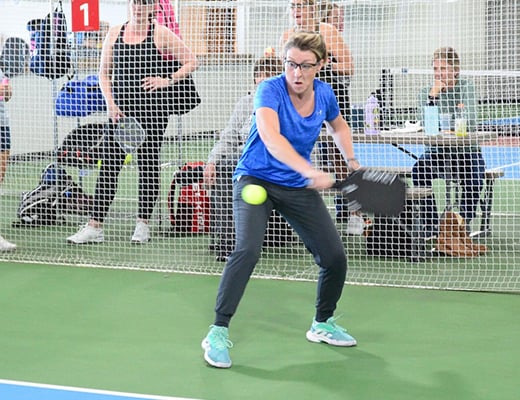When Caro Henauw takes up a new hobby, she doesn’t dink around. She launches in with overhead-smash-style gusto.
Such was the case with pickleball. Henauw, grants and contracts manager at the University of Colorado Anschutz Health and Wellness Center (AHWC), played a game at a friend’s suggestion and within a couple weeks she had over 100 new pickleball contacts in her phone. “And then six months into it, we reached a thousand people,” helped along by social media, she said.
This pickleball micro-burst – part of the country’s wider explosion (it’s the fastest-growing sport in the U.S., increasing 159% over three years) – took place in summer 2021, a year into the COVID pandemic. The sport’s safe social-distance aspect drew people out of their pandemic cocoons, igniting a hard-court phenomenon that is expected to grow to 22 million players this year.
Two months into her new habit, which quickly became five outings a week, Henauw developed tendonitis in her shoulder.
Dislocated shoulders, replaced knees
That’s just the tip of the paddle in terms of injuries that Henauw and other pickleball enthusiasts have seen or heard about as they step onto their favored – both indoor and outdoor – playing surfaces. According to a recent study that looked at statistics from 2010 to 2019, over 85% of emergency room visits due to pickleball-related injuries were to players over 60. About 60% of the injuries were sprains, strains, tears and fractures.

Henauw reduced her playing time to let her shoulder heal. Meanwhile, one of her friends has had two knee replacements since taking up the sport. “She’s better than I am now, and she’s 55,” said Henauw, 48.
On another occasion, “I had a friend who had to really dive for a ball and landed on her shoulder and dislocated it,” noting that an ambulance was called. “They couldn’t even pop it back in on the spot, and she was in a lot of pain. Then she had to go in for surgery.”
Henauw has anecdotally heard of more of these types of injuries in pickleball than, say, tennis. The sport, played on smaller-sized courts, is a hybrid of tennis, badminton and table tennis.
Pickleball offers a “great workout,” Henauw said, but she recommends building up slowly. She suggests spending a bit more on “really good gear,” including tennis shoes – not running shoes – as well as protective eyewear. She has a friend whose eye got scratched when the ball, made of hard plastic, caromed off the edge of her paddle and into her face.
Ramp up slowly – no matter your age
Lauren Heap, personal training manager at the CU Anschutz Health and Wellness Center, said pickleball demands a lot of lateral movements, making people susceptible to ankle rolls, sprains and Achilles injuries.
|
Tips to avoid injury on the pickleball court
|
“These are quicker, athletic movements that we don’t do every day,” she said. “I watched a girl actually tear her Achilles when I was playing once. She was young, 28, and she went sideways and then was trying to lunge forward for the ball and then just fell over. That was not good. … One of our clients (at the AHWC) is a big surfer, and he tore his Achilles, too, from playing pickleball.”
Heap said players should warm up sufficiently – calf, ankle and hamstring stretches, leg and hip swings, core twists and stretches, loosening their arms, shoulders and wrists – before stepping on the court.
She said pickleball doesn’t require hitting the ball “crazy hard,” but it does demand a lot of motion in the shoulders and wrists. New players should ease in by playing about 20 minutes and gradually ramping to 30, then 40 minutes and “gradually increasing until you feel comfortable,” Heap said.
The games, which go to 11, are generally quick, and participants can lower their exertion by playing doubles. Heap has noticed the sport, which originally drew a senior crowd, is now also popular with young and middle-aged players.
‘Where your friends are’
“I’m 32, and it’s a way to hang out with friends, do something active and fun, but not too intense,” she said. “You can enjoy it.”
When Henauw started, she was in her mid-40s and the youngest member of her ever-expanding pickleball crew. She has dialed back to playing about three times a week.
She firmly believes pickleball’s explosion was rooted in the social, mental health outlet it offered during the pandemic. You could enjoy friends without food or drinks being involved.
I told myself before last summer, ‘I can’t forget about the bikes,’ but they’re hanging off the ceiling of my garage just gathering dust,” Henauw said. “Again, I have the intention of biking this summer, but we’ll see. There are only so many hours in the day, and you tend to go where your friends are, right?”




